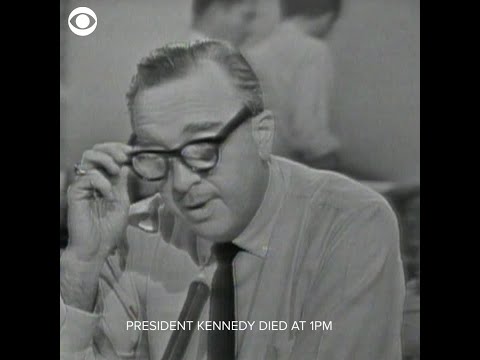HISTORY's Moment in Media: JFK's Assassination Ushers in a New Age of Breaking News Television

It was a day that changed history, changed the presidency and changed the country. It was also a day that brought us the first major live breaking-news event of the television era, the first time seemingly the entire nation gathered around their sets to watch anchormen (and, yes, they were all men back then) fill airtime as they waited for new news to report, and then learned from those anchormen, together, about the tragic news that was unfolding.
November 22, 1963, 60 years ago this month, was the fateful day President John F. Kennedy was assassinated in a motorcade as it passed the Texas School Book Depository in Dallas. That afternoon, America watched as stalwart CBS newsman Walter Cronkite famously struggled to maintain his composure as he announced to a shocked nation -- after breaking into a broadcast of As the World Turns-- that the president was dead.
Kennedy was killed on a Friday and buried at Arlington National Cemetery on the following Monday, and in those four days Cronkite and his colleagues set the template for what major-event live news coverage would be. Television was still a new medium then. In 1950, only nine percent of U.S. households owned a TV set, but by 1960, 90 percent did. Kennedy had been the first television president, with a natural affinity for the medium. But even into his presidency, television reporters were still considered unserious; the real journalists, according to conventional wisdom, worked in print.
But when the first reports came of a shooting in Dallas -- by radio, for the most part -- people flocked to their TVs. These were the days of just three networks, and all three went live with wall-to-wall coverage, without any commercial interruption. That was then unprecedented -- and wouldn't be repeated for such a length of time until after 9/11.
"Modern television," a New York Times critic wrote on the 50th anniversary, "was born on the day John F. Kennedy died."
The idea of broadcasting from the scene where possible, with a studio-based anchor as master of ceremonies, was established that weekend. But the technology of the day made it more challenging: cameras were big, bulky and heavy, and required connections to heavy wires and power supplies.
Still, on-location cameras paid off. On the night of November 24, reporters crowded the basement of the Dallas police headquarters to witness the transfer of suspect Lee Harvey Oswald to a more secure county jail. When nightclub owner Jack Ruby charged forward and shot Oswald, fatally wounding him, NBC's viewers saw Ruby's shot as it happened, as the network had a live camera there. CBS wasn't live but did have equipment on location and broadcast a tape moments later. ABC viewers missed it; that network had already moved its live equipment to the county jail in anticipation of Oswald's arrival.
Overall, viewership numbers that weekend were remarkable. According to Nielsen, 45.4 percent of all American homes with televisions were watching at 2:45 p.m. Eastern Time on November 22, just after the White House announced the president's death. By 6:15 p.m. that day, when Lyndon Johnson, the new president, spoke from the White House, 65.8 percent of all homes with TVs were watching. Some 47.2% of homes with TVs were watching in the moments after Ruby show Oswald, and an amazing 81% of all homes with TVs watched as the slain president's body arrived at Arlington on November 25.
Today, while many of the coverage methods remain the same, Americans no longer come together for big moment in the same way -- and certainly not to just three networks.
On the evening of September 11, 2001, the biggest modern news event, about 80 million people tuned into news broadcasts across four major broadcast networks, three major 24-hour news networks and assorted other broadcast and cable networks.
That was also perhaps the first major event when online news was a factor. One analyst reported that general news websites like CNN.com and MSNBC.com had been averaging about 17.5 million weekly visitors earlier in 2001 but nearly doubled their audience to 34.5 million weekly visitors during the week of September 11.
Of course, by today's standards, which was still nothing. By 2022, CNN.com was averaging 130 million unique visitors each month. The New York Timesboasted 145 million monthly web visitors for that same year. And then there's all the online sources that aren't traditional news organizations: last year the Pew Research Center found that half of Americans get at least some of their news from social media. About a third said they regularly get news from Facebook, about a quarter from YouTube and less than 15 percent each from Twitter, Instagram and TikTok.
But in the same study, Pew also found that nearly two-thirds of American adults still sometimes or often get their news the way people have since JFK's day, from TV.
Click the social buttons to share this story with colleagues and friends.
The opinions expressed here are the author's views and do not necessarily represent the views of MediaVillage.org/MyersBizNet.

